|
|
+++ The Holy Emperor Constantine and the Empress Helena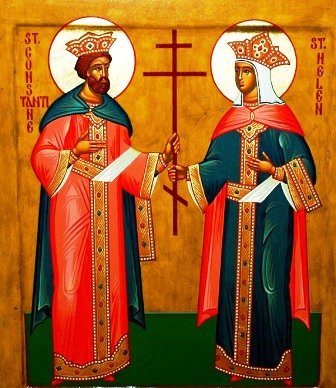 Constantine's parents were the Emperor Constantius Chlorus and the Empress Helena. Chlorus had further children by another wife, but by Helena he had only the one, Constantine. Constantine fought two great battles when he came to the throne: one against Maxentius, a tyrant in Rome, and the other against Licinius not far from Byzantium. At the battle against Maxentius, when Constantine was in great anxiety and uncertainty about his chances of success, a shining cross, surrounded by stars, appeared to him in the sky in full daylight. On the cross were written the words: 'In this sign, conquer!' The wondering Emperor ordered that a great cross be put together, like the one that had appeared, and be carried before the army. By the power of the Cross, he gained a glorious victory over enemies greatly superior in number. Maxentius drowned himself in the Tiber. Immediately after this, Constantine issued the famous Edict of Milan, in 313, to put an end to the persecution of Christians. Conquering Byzantium, he built a beautiful capital city on the Bosphorus, which from that time was named Constantinople.
At this time, Constantine fell ill with leprosy. The pagan priests and doctors advised him to bathe in the blood of slaughtered children, which he refused to do. Then the Apostles Peter and Paul appeared to him and told him to seek out a bishop, Sylvester, who would heal him of the disease. The bishop instructed him in the Christian faith and baptised him, and the leprosy vanished from the Emperor's body.
When there was discord in the Church about the troublesome heretic Arius, the Emperor summoned the first Ecumenical Council in Nicaea, in 325, where the heresy was condemned and Orthodoxy confirmed.
St Helena, the Emperor's devout mother, was very zealous for the Christian faith. She visited Jerusalem and found the Precious Cross of the Lord, and built the Church of the Resurrection over Golgotha and many other churches in the Holy Land. This holy woman went to the Lord in 327, at the age of eighty. The Emperor Constantine outlived his mother by ten years and entered into rest at the age of about sixty in 337, in the city of Nicomedia. His body was buried in the Church of the Holy Apostles in Constantinople. Constantine's parents were the Emperor Constantius Chlorus and the Empress Helena. Chlorus had further children by another wife, but by Helena he had only the one, Constantine. Constantine fought two great battles when he came to the throne: one against Maxentius, a tyrant in Rome, and the other against Licinius not far from Byzantium. At the battle against Maxentius, when Constantine was in great anxiety and uncertainty about his chances of success, a shining cross, surrounded by stars, appeared to him in the sky in full daylight. On the cross were written the words: 'In this sign, conquer!' The wondering Emperor ordered that a great cross be put together, like the one that had appeared, and be carried before the army. By the power of the Cross, he gained a glorious victory over enemies greatly superior in number. Maxentius drowned himself in the Tiber. Immediately after this, Constantine issued the famous Edict of Milan, in 313, to put an end to the persecution of Christians. Conquering Byzantium, he built a beautiful capital city on the Bosphorus, which from that time was named Constantinople.
At this time, Constantine fell ill with leprosy. The pagan priests and doctors advised him to bathe in the blood of slaughtered children, which he refused to do. Then the Apostles Peter and Paul appeared to him and told him to seek out a bishop, Sylvester, who would heal him of the disease. The bishop instructed him in the Christian faith and baptised him, and the leprosy vanished from the Emperor's body.
When there was discord in the Church about the troublesome heretic Arius, the Emperor summoned the first Ecumenical Council in Nicaea, in 325, where the heresy was condemned and Orthodoxy confirmed.
St Helena, the Emperor's devout mother, was very zealous for the Christian faith. She visited Jerusalem and found the Precious Cross of the Lord, and built the Church of the Resurrection over Golgotha and many other churches in the Holy Land. This holy woman went to the Lord in 327, at the age of eighty. The Emperor Constantine outlived his mother by ten years and entered into rest at the age of about sixty in 337, in the city of Nicomedia. His body was buried in the Church of the Holy Apostles in Constantinople.Saint Helen (Jelena) of Dechani, Serbia (1350)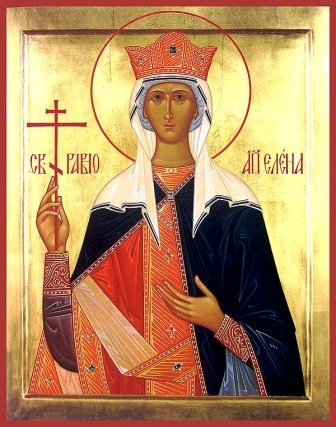 Saint Jelena of Decani was the sister of Stefan Uroš III. Saint Jelena of Decani was the sister of Stefan Uroš III. Our Holy Father, the Martyr PachomiusBorn in Little Russia, he was taken by the Tartars as a boy and sold to a Turkish tanner as a slave. He spent twenty-seven years in slavery in Usaki in Asia Minor, and was forced to embrace Islam. He went off to the Holy Mountain, became a monk and spent twelve years near the monastery of St Paul. He resolved to suffer for Christ. His spiritual elder, Joseph, sent him off to Usaki, where he showed himself to his former owner as a Christian, wearing his monastic habit. The Turks gave him over to torture, then threw him into prison and finally beheaded him on May 8th, 1730, on Ascension Day. Many miracles were wrought by his blood and his relics, his body being buried on the island of Patmos in the Church of St John the Theologian. Thus this villager from Little Russia became a martyr and wears the wreath in the Kingdom of Christ.
Saint Constantine (1205) and his children Sts. Michael and Theodore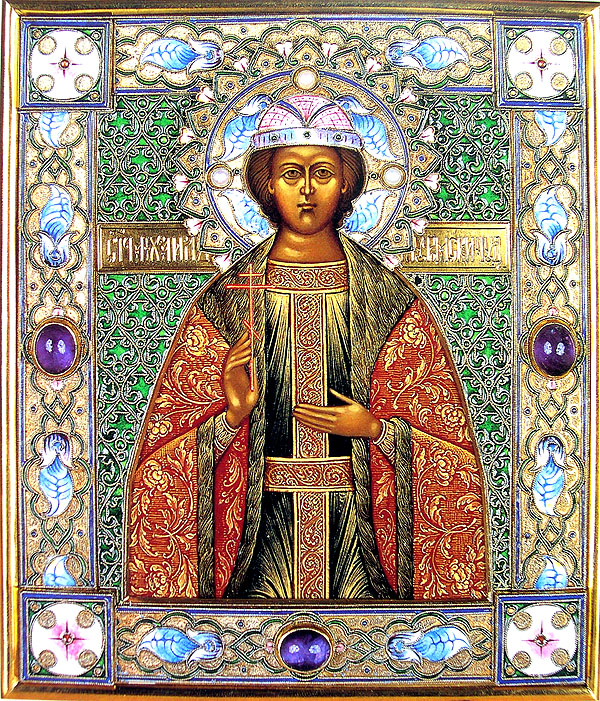 The Blessed Holy Princes Konstantin (Constantine) and his sons Michael and Theodore (Feodor) of Murom lived during the XI-XII Centuries. Blessed Prince Konstantin, a descendant of Equal-to-the-Apostles Vladimir, besought of his father, prince Svyatoslav of Chernigov, to give him as his appenage-holding the city of Murom, which was inhabited by pagans, so as to enlighten this land with the light of the Christian faith. The prince sent his son Michael in the capacity of emissary to the Muromsk people, but the pagans murdered him... The Blessed Holy Princes Konstantin (Constantine) and his sons Michael and Theodore (Feodor) of Murom lived during the XI-XII Centuries. Blessed Prince Konstantin, a descendant of Equal-to-the-Apostles Vladimir, besought of his father, prince Svyatoslav of Chernigov, to give him as his appenage-holding the city of Murom, which was inhabited by pagans, so as to enlighten this land with the light of the Christian faith. The prince sent his son Michael in the capacity of emissary to the Muromsk people, but the pagans murdered him...Venerable Cassian the Greek, monk, of Uglich (1504)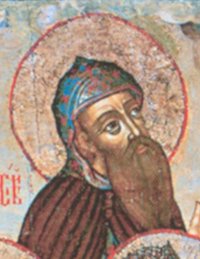 The Monk Kassian the Greek, Wonderworker of Uglich, in the world Konstantin, was descended in lineage from the princes Mangupides. He arrived in Moscow as part of the legation to Greatprince Ivan III, together with the daughter of the Byzantine emperor, Sophia Paleologa. Having decided to devote his life to the service of God, the saint declined the offer to remain at the court of the Greatprince, and he resettled to the Rostov bishop Joasaph. When the bishop withdrew for quietude to the Pherapontov monastery, Konstantin followed him... The Monk Kassian the Greek, Wonderworker of Uglich, in the world Konstantin, was descended in lineage from the princes Mangupides. He arrived in Moscow as part of the legation to Greatprince Ivan III, together with the daughter of the Byzantine emperor, Sophia Paleologa. Having decided to devote his life to the service of God, the saint declined the offer to remain at the court of the Greatprince, and he resettled to the Rostov bishop Joasaph. When the bishop withdrew for quietude to the Pherapontov monastery, Konstantin followed him...Venerable Agapitus, abbot of Markushev (Vologda) (1578)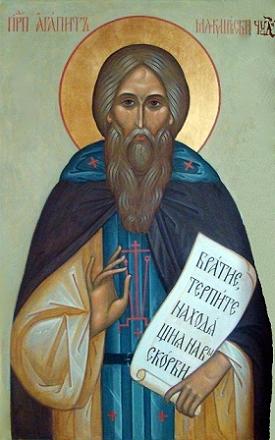 The MonkMartyr Agapit of Makrushevsk, the founder of the Makrushevsk Nikolaev monastery, was a companion of the Monk Longin of Koryazhemsk. At one point at the Sol'vychegodsk Borisoglebsk monastery, during a time of illness he was granted a vision from an icon of Saint Nicholas, through whom he was healed. Setting out to the place indicated in the vision, he at first built there a chapel, and when a monastery formed, in 1578 he erected two churches – the one in name of Saint Nicholas and the other in honour of the Annunciation of the MostHoly Mother of God. The local inhabitants wanted to eradicate the monastery. They murdered the Monk Agapit on 21 May 1584 and threw his body in a river. But the monks found the body and gave it burial betwixt the temples, building at the place of burial a chapel, and at the crypt they put the chains of the saint. Afterwards the relics were transferred and placed beneathe a crypt in the monastery church. In the year 1712 the Kholmogorsk bishop Varnav (Barnabas) gave blessing to the brethren to gather together an account about the life of the Monk Agapit and about the miracles from the Velikoretsk Icon. And with his blessing, in 1715 was written the Vita-Life of the MonkMartyr Agapit. The MonkMartyr Agapit of Makrushevsk, the founder of the Makrushevsk Nikolaev monastery, was a companion of the Monk Longin of Koryazhemsk. At one point at the Sol'vychegodsk Borisoglebsk monastery, during a time of illness he was granted a vision from an icon of Saint Nicholas, through whom he was healed. Setting out to the place indicated in the vision, he at first built there a chapel, and when a monastery formed, in 1578 he erected two churches – the one in name of Saint Nicholas and the other in honour of the Annunciation of the MostHoly Mother of God. The local inhabitants wanted to eradicate the monastery. They murdered the Monk Agapit on 21 May 1584 and threw his body in a river. But the monks found the body and gave it burial betwixt the temples, building at the place of burial a chapel, and at the crypt they put the chains of the saint. Afterwards the relics were transferred and placed beneathe a crypt in the monastery church. In the year 1712 the Kholmogorsk bishop Varnav (Barnabas) gave blessing to the brethren to gather together an account about the life of the Monk Agapit and about the miracles from the Velikoretsk Icon. And with his blessing, in 1715 was written the Vita-Life of the MonkMartyr Agapit. |